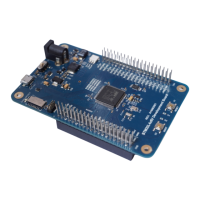DocID024597 Rev 3 141/1693
RM0351 Power control (PWR)
178
can be enabled to confirm whether the supply is present or not.
The following sequence must be done before using the USB_OTG peripheral:
1. If V
DDUSB
is independent from V
DD
:
a) Enable the PVM1 by setting PVME1 bit in the Power control register 2
(PWR_CR2).
b) Wait for the PVM1 wakeup time
c) Wait until PVMO1 bit is cleared in the Power status register 2 (PWR_SR2).
d) Optional: Disable the PVM1 for consumption saving.
2. Set the USV bit in the Power control register 2 (PWR_CR2) to remove the V
DDUSB
power isolation.
The following sequence must be done before using any I/O from PG[15:2]:
1. If V
DDIO2
is independent from V
DD
:
a) Enable the PVM2 by setting PVME2 bit in the Power control register 2
(PWR_CR2).
b) Wait for the PVM2 wakeup time
c) Wait until PVMO2 bit is cleared in the Power status register 2 (PWR_SR2).
d) Optional: Disable the PVM2 for consumption saving.
2. Set the IOSV bit in the Power control register 2 (PWR_CR2) to remove the V
DDIO2
power isolation.
The following sequence must be done before using any of these analog peripherals: analog
to digital converters, digital to analog converters, comparators, operational amplifiers,
voltage reference buffer:
1. If V
DDA
is independent from V
DD
:
a) Enable the PVM3 (or PVM4) by setting PVME3 (or PVME4) bit in the Power
control register 2 (PWR_CR2).
b) Wait for the PVM3 (or PVM4) wakeup time
c) Wait until PVMO3 (or PVMO4) bit is cleared in the Power status register 2
(PWR_SR2).
d) Optional: Disable the PVM3 (or PVM4) for consumption saving.
2. Enable the analog peripheral, which automatically removes the V
DDA
isolation.
5.3 Low-power modes
By default, the microcontroller is in Run mode after a system or a power Reset. Several low-
power modes are available to save power when the CPU does not need to be kept running,
for example when waiting for an external event. It is up to the user to select the mode that
gives the best compromise between low-power consumption, short startup time and
available wakeup sources.
The device features seven low-power modes:
• Sleep mode: CPU clock off, all peripherals including Cortex
®
-M4 core peripherals such
as NVIC, SysTick, etc. can run and wake up the CPU when an interrupt or an event
occurs. Refer to Section 5.3.4: Sleep mode.
• Low-power run mode: This mode is achieved when the system clock frequency is
reduced below 2 MHz. The code is executed from the SRAM or the Flash memory. The

